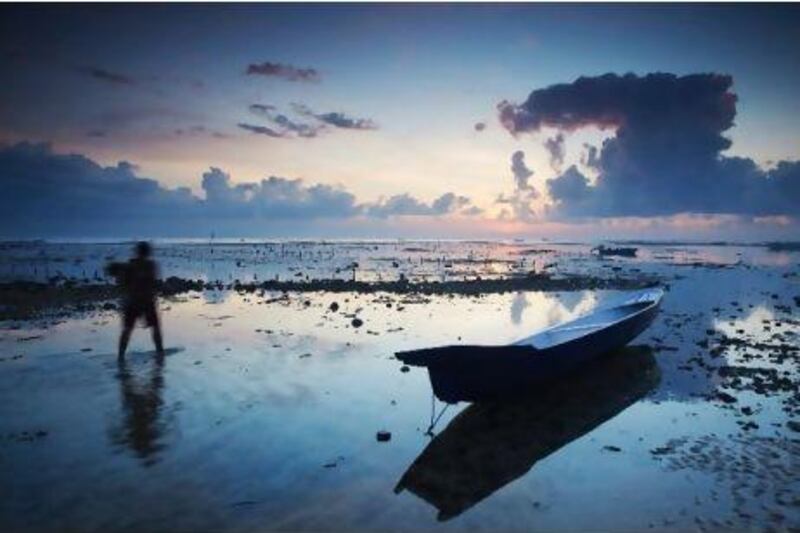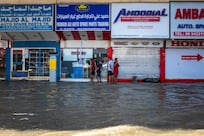It is late afternoon and up on the sun deck of the Bali Hai II catamaran we must look a ragtag bunch. Two golden-haired children sleep on the floor, their sandy toes peeping out from beach towels used as blankets. A group of friends - the girls with their hair braided, the guys with their shorts slung low and T-shirts discarded - chatter and laugh. A couple of surfers slouch languidly and flirt with any lone female who crosses their path.
It is my last full day here and I'm on my way back from a cruise to Nusa Lembongan, a small island off Bali's south-east coast. If I'm honest I hadn't expected to enjoy this particular part of the trip. It had all sounded a bit too prepackaged for my tastes; an "excursion" - shudder - that came with the heart-sinking prospect of "activities", including a tug of war on the beach. How am I going to discover Bali if I'm busy fending off the advances of some clipboard-wielding organiser?
But the reality has proved very different and the only activities to have interrupted me reclining beneath a tiki-style shade have been a massage overlooking the Indian Ocean and a lazy stroll picking over the sand for the faint blush of broken coral.
I suppose by now I should have worked out that the only thing anyone in Bali would dream of urging you to do is to find whatever brings you pleasure and enjoy it.
Four days earlier and I'm boarding the night flight from Abu Dhabi via Singapore to Bali's main airport in the capital, Denpasar. "Eat, Pray, Love!" the air hostess welcomes me. "Ah... Eat, Pray, Love," smiles another as I am shown to my seat. Was that a hint of sympathy? It takes me a moment to realise that, due to a lack of packing prowess and preparation, I am carrying the book I had intended to finish well before this point.
Ah yes, Elizabeth Gilbert's Eat, Pray, Love - the bestselling chronicle of an American divorcee who spends a year travelling in Italy, India and Bali in search of fulfilment and romance. It is my map of sorts and required reading for any woman of a certain age and at a certain place in her life travelling alone to Bali.
So far I have surmised this much: I must have my fortune told by a wise man called Ketut, I must find a medicine woman who will cure me of ills I never knew I had and I must hire a bicycle and get run over by a sexy Brazilian man driving a jeep.
The thing is I'm not very good with maps. I tend to get lost then discard them in a fit of pique, so perhaps a certain degree of deviation from the route laid down by Ms Gilbert should have been anticipated.
The drive south from Denpasar to Nusa Dua Beach Resort, my home for the first two nights, takes about an hour. Nusa Dua (the literal translation is "two beaches") is a purpose-built nine-hectare enclave where you could spend your whole holiday and no doubt have a perfectly lovely time. But to do so would be to miss an awful lot because although one version of Bali exists within Nusa Dua's bougainvillaea-draped walls - beach, spa, exquisite gardens - another seethes beyond them, as I find out the following day with a trip to Kintamani. A couple of hours north, this is the location of Mount Batur, one of Bali's two volcanoes, with Lake Batur within its caldera.
Four million people live on Bali and at any given time most of them seem to be trying to navigate the roads that wind along its coast or up into the lush volcanic heartland. Mopeds, loaded high and wide with entire families, groceries, pieces of furniture and parts of engines, tear alongside tiny trucks and taxis. Open-fronted roadside huts sell a jumble of goods: garden ornaments, coconuts and bags of delicious Balinese coffee.
We stop twice on the way to Kintamani. First is a visit to a traditional Balinese village where frangipani and bougainvillaea abound. There are so many flowers, my guide explains, because Bali's Hindu beliefs call for so many daily offerings to the gods. The little woven baskets containing flowers, fruits and sometimes bread can be found at every door, along pavements and even, rather battered, in the street.
At the far end of the village, a couple of porcupines doze in bamboo cages, their quills flattened. These, I am told, taste better than chicken. Next to them several roosters sit or strut, each in its own bell-shaped cage. "These are for fighting," my guide whispers. "They get massage every day. Very important." The birds preen as if aware of their status.
Next comes a tour of Penglipuran Pura Tirta Empul, where visitors can drink, or clamber into, holy waters (a fact that frankly puts me off the former option). I am struck by the number of mopeds that have assembled by the gates. "Is there a festival?" I wonder. "No," my guide says, "a cockfight." I want to pick my way through the throng and see it since it sounds far more intriguing than Gilbert's hours of meditation and contemplation. But I'm told in no uncertain terms that it is "very illegal - if police come, everybody run". So it's back in the tiny truck and onto Kintamani.
You can trek up the volcano's side but, given that I am wearing flip flops, it comes as a relief to discover that the most challenging climb on the agenda is up the steps to the hotel on whose panoramic platform lunch is served.
Both the volcanoes on Bali are active. "When did this one last erupt?" I ask while chewing on a spicy beef skewer dipped in Kecap Manis, a sweet soy sauce. "1963," comes the answer. "And 1970s... and 1994, 1998, 1999 and in 2000 a little." I'm beginning to understand why appeasing the gods is such a big deal here. Earlier I had heard about the earthquakes that felled the original Pengeboran Temple buildings in 1917, 1963 and 1979.
We take a different route back south via Ubud, the town in which Gilbert stayed. The first clue to this is a blue signpost towards some locations where Julia Roberts and company filmed the movie version of the book. Strange as it might sound, I have been so absorbed by the day thus far that I've forgotten my admittedly loose Eat, Pray, Love plan. The reminder comes as a faint and unwelcome jolt back to reality.
It doesn't help that despite what Ubud might once have been, it has now become something of an Eat, Pray, Love theme park. Quite suddenly I don't want to be here in the supposed traditional market that's filled with souvenirs made somewhere else. I don't want to stand in a queue alongside middle-aged divorcees waiting for an appointment with Wayan the medicine woman. I don't want somebody to tell me my future. I don't want to find myself if this is where I am when I do.
A night in Kuta is in order. This is south Bali's party region, 40 minutes' taxi ride from Nusa Dua. It is rowdy, tacky and its bars and clubs crowded with young Balinese, assorted tourists and the island's semi-permanent residents: surfers, mostly from Australia, who come to the island and stay for months. It is the antithesis of the contemplative life and it's fun. A night in Kuta is best followed by a restorative late morning spa treatment. One full body massage, one frangipani petal bath and a sweet ginger tea later, it's time to check out of Nusa Dua and move on to Sanur.
A couple of hours drive from Nusa Dua, Sanur is popular with European tourists and it's easy to see why. The main road curves round the coast in a stretch of chichi boutiques, restaurants and hotels. In the evenings it's a people watcher's paradise: funky, engaging and offering seemingly endless options and opportunities.
Everything is colourful and adorned with ornament and, because of the Balinese planning rules for the area, no building is taller than a coconut tree. It's lovely. Coming hot on the heels of my visit to Ubud, it strikes me as ironic that so many people come to Bali looking for balance - a notion at the heart of this island's belief system - and that as a result Bali must struggle to adjust and maintain its own. This, after all, is an island with few natural resources other than its people and its culture. But how do you sell that without losing it? Most locals work in the tourist industry. There are 2,190 hotels, 299 licensed travel agents, 5,258 licensed tour guides and who knows how many that are unlicensed. Those who don't work in tourism scratch out a living from farming terraced rice fields and small holdings, and fixing everything from engines to people.
I do meet a Ketut in Bali, only mine is not Gilbert's smiling sage but the smiling assistant head of marketing for Bali's tourist board. "Bali is like a sip," he tells me. I nod at this profound insight. Wait, Bali's a what? "A sip, a sip," he repeats waggling a hand. "On the water." Oh, a ship!
"We need tourist but we must be careful. Can only take so many people or it will sink." The way Ketut sees it, the Balinese don't own Bali, they simply make sure it stays on an even keel, economically, environmentally and culturally. It is a difficult task made harder by the bombings in 2002 and 2005 from which, Ketut says, they are still recovering.
I think about Ketut's words on my final day as I board the Bali Hai II, the catamaran that will take me to Nusa Lembongan on the cruise that I had anticipated with misgivings. And up on the catamaran's sundeck during that cruise home, after that blissful day in which all those misgivings have been dispelled, I have my own little revelation of sorts.
The surge of tourists brought on the back of Gilbert's 2006 book was a blessing for the island's already well-established hospitality industry. With the release of the film version four years later, that blessing is decidedly more mixed as thousands attempt to follow in her footsteps only to find the path she took is now paved and lined with souvenir shops. It's an easy sell to western city-dwellers: Bali is a spiritual place and people do smile - a lot. And it's also beautiful, from the south's white beaches to the north's black volcanic ones and the lush interior. But somehow, that sells it short. Bali isn't paradise. It is much more interesting than that.
The only thing my Ketut urged me to do was to connect with the Balinese people, to be open to whatever Bali has to offer and to know that it will be open to you in return. It turns out that really isn't very difficult. For every wind-chime echoing spa, there are vast stretches of messy, chaotic Bali with its roadside shacks, street food and cockfighting.
Perhaps that's the beauty of the place. Gilbert found her own version and in the process found herself. But you're not going to find yourself by looking in all the same places as somebody else. Besides, she had four months. I had four days. So no, I didn't find myself in Bali. I jettisoned the map and I lost myself. And I loved it.
If you go
Singapore Airlines (www.singaporeair.com) flies from Abu Dhabi to Denpasar, Bali via Singapore five times a week. Flights cost from Dh3,730
Nusa Dua Beach Hotel and Spa starts at Dh840 for a deluxe double or twin based on two people (www.nusaduahotel.com) The Oasis Lagoon Hotel, Sanur, starts at Dh330 deluxe double or twin based on two sharing
For more information on Golden Rama Tours visit www.golden-rama.com or email edp@golden-rama.com A combined holiday to Bali with a stopover in Singapore starts from Dh180 per night on a twin-share basis, inclusive of hotel accommodation, airport-hotel transfers and city-sightseeing bus. For Bali holiday packages, contact Singapore Airlines, Abu Dhabi ticket office 02 622 1110/1923 or email: sia_abudhabi@singaporeair.com.sq





